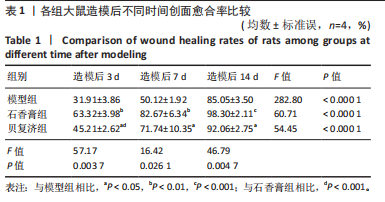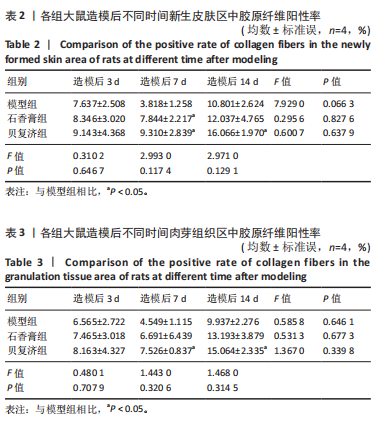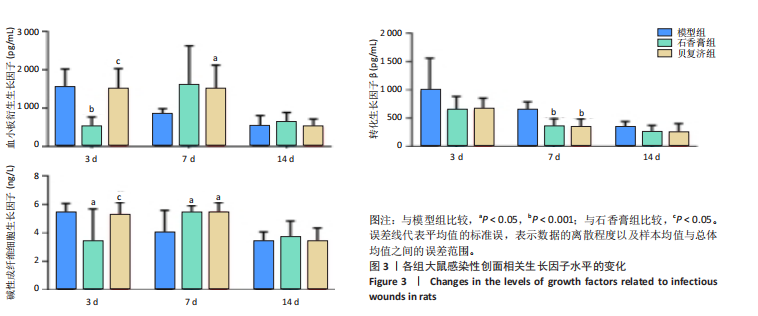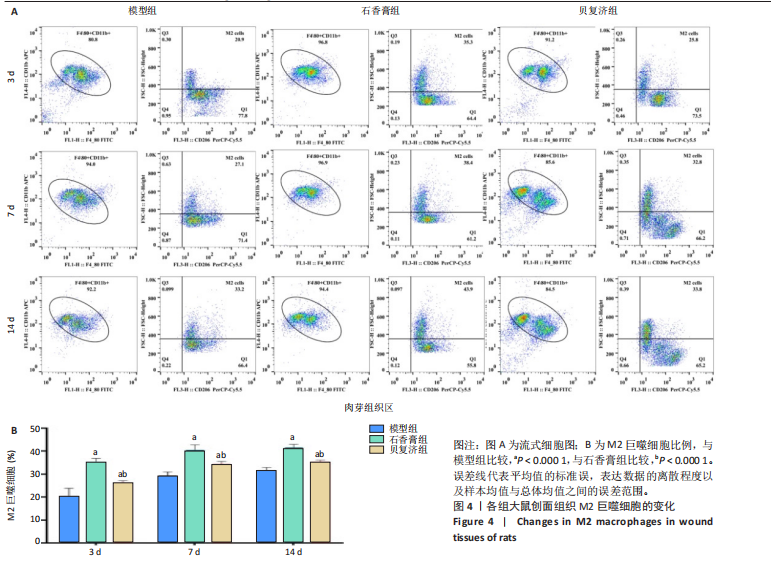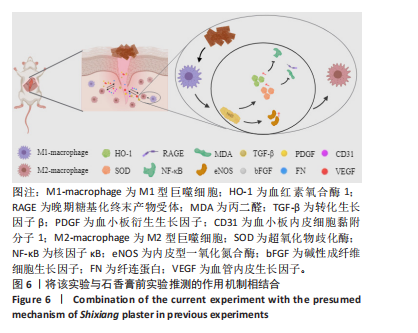[1] FRYKBERGROBERT G. Challenges in the treatment of chronic wounds. Adv Wound Care (New Rochelle). 2015;4(9):560-582.
[2] CLINTON A, CARTER T. Chronic wound biofilms: pathogenesis and potential therapies. Lab Med. 2015;46(4):277-284.
[3] GJøDSBøL K, CHRISTENSEN JJ, KARLSMARK T, et al. Multiple bacterial species reside in chronic wounds: a longitudinal study. Int Wound J. 2006;3(3):225-231.
[4] CHEN H, ZHANG J, HE Y, et al. Exploring the role of Staphylococcus aureus in inflammatory diseases. Toxins (Basel). 2022;14(7):464.
[5] VOS T, ALLEN C, ARORA M, et al. Global, regional, and national incidence, prevalence, and years lived with disability for 310 diseases and injuries, 1990–2015: a systematic analysis for the Global Burden of Disease Study 2015. Lancet. 2016;388(10053):1545-1602.
[6] FALANGA V, ISSEROFF RR, SOULIKA AM, et al. Chronic wounds. Nat Rev Dis Primers. 2022;8(1):50.
[7] OBAGI Z, DAMIANI G, GRADA A, et al. Principles of wound dressings: a review.Surg Technol Int. 2019;35:50-57.
[8] VERDÚ-SORIANO J, CASADO-DÍAZ A, DE CRISTINO-ESPINAR M, et al. Hard-to-Heal Wound Healing: Superiority of Hydrogel EHO-85 (Containing Olea europaea Leaf Extract) vs. a Standard Hydrogel. A Randomized Controlled Trial. Gels. 2023;9(12):962.
[9] VITSE J, TCHERO H, MEAUME S, et al. Silver sulfadiazine and cerium nitrate in ischemic skin necrosis of the leg and foot: Results of a prospective randomized controlled study. Int J Low Extrem Wounds. 2018;17(3):151-160.
[10] ZHANG J, CHEN X, YU L, et al. The treatment of low leg nonischemic ulcers with a traditional Chinese-pharmaceutical medium: a randomized controlled multicenter clinical study. Int J Low Extrem Wounds. 2019;18(2):186-191.
[11] 赵杰, 孙业祥. 浅析“煨脓长肉”理论在慢性难愈合创面中的作用机制及研究进展[J].中国烧伤创疡杂志,2024,36(6):425-428.
[12] 刘曼, 张开伟. 基于“煨脓长肉”理念用石香膏促进慢性难愈性创面修复临床观察[J].实用中医药杂志,2024,40(3):423-425.
[13] 凌一鸣, 费冀, 张开伟, 等. 中药石香膏对糖尿病大鼠慢性难愈合创面RAGE/NF-κBp65/eNOS mRNA表达影响的研究[J].中国中医基础医学杂志,2019,25(7):913-917.
[14] 凌一鸣, 费冀, 张开伟, 等. 石香膏对糖尿病慢性难愈合创面模型大鼠创面组织血管内皮细胞黏附分子1、核因子κB p65表达的影响[J].中医杂志,2020,61(7):619-625.
[15] 费冀, 张开伟, 周一夫, 等. 石香膏干预糖尿病溃疡创面模型大鼠创面组织晚期糖基化终产物及其受体与内皮型一氧化氮合成酶表达的变化[J].中国组织工程研究,2022,26(20):3196-3201.
[16] 刘志伦, 关智宇, 蒋太平, 等. 石香膏干预大鼠感染难愈创面的愈合机制[J].中国组织工程研究,2023,27(26):4126-4131.
[17] 李文华, 刘筱, 周雯婷, 等. 慢性难愈合创面动物模型制备方法的评价与选择 [C].第15届全国烧伤创疡学术会议论文汇编会议论文集,浏阳:2018.
[18] 张晓倩, 王巍, 贾茹, 等. 炉甘石炮制前后治疗大鼠湿疹作用比较研究[J].广东化工,2022,49(2):31-32+40.
[19] ASIF N, AMIR M, FATMA T. Recent advances in the synthesis, characterization and biomedical applications of zinc oxide nanoparticles. Bioprocess Biosyst Eng. 2023;46(10):1377-1398.
[20] KHAJEHDEHI M, KHALAJ-KONDORI M, BARADARAN B.Molecular evidences on anti‐inflammatory, anticancer, and memory‐boosting effects of frankincense. Phytother Res. 2022;36(3):1194-1215.
[21] BATIHA GE, WASEF L, TEIBO JO, et al. Commiphora myrrh: a phytochemical and pharmacological update. Naunyn Schmiedebergs Arch Pharmacol. 2023;396(3):405-420.
[22] CAO B, WEI XC, XU XR, et al. Seeing the unseen of the combination of two natural resins, frankincense and myrrh: Changes in chemical constituents and pharmacological activities. Molecules. 2019;24(17): 3076.
[23] SU X, HAO S, LI W, et al. Gardenia fruit and Eucommia leaves combination improves hyperlipidemia and hyperglycemia via pancreatic lipase and AMPK-PPARαand Keap-1-Nrf2-HO-1 regulation. J Functional Foods. 2023;100:105394.
[24] 白育军, 何希瑞, 白亚军, 等. 冰片及其酯/酰胺类衍生物的合成和活性研究进展[J].化学通报,2021,84(11):1173-1185.
[25] PICKUP MJ. Pathophysiology of Wound Healing. Forensic and Legal Medicine. CRC Press. 2023:103-107.
[26] PINTUCCI G, FROUM S, PINNELL J, et al. Trophic effects of platelets on cultured endothelial cells are mediated by platelet-associated fibroblast growth factor-2 (FGF-2) and vascular endothelial growth factor (VEGF). Thromb Haemost. 2002;88(5):834-842.
[27] NATH SG, RAVEENDRAN R. An insight into the possibilities of fibroblast growth factor in periodontal regeneration. J Indian Soc Periodontol. 2014;18(3):289-292.
[28] CATANZANO O, QUAGLIA F, BOATENG JS. Wound dressings as growth factor delivery platforms for chronic wound healing. Expert Opin Drug Deliv. 2021;18(6):737-759.
[29] FEI J, WANG LL, LIU M, et al. Study on the effect of Shixiang plaster on the expression of CD31, serum FN, and VEGF in a rat model with chronic wounds. Tradit Med Res. 2024;9:68-73.
[30] SANZ-HORTA R, MATESANZ A, GALLARDO A, et al. Technological advances in fibrin for tissue engineering. J Tissue Eng. 2023;14: 20417314231190288.
[31] GUO X, YANG L, DENG C, et al. Nanoparticles traversing the extracellular matrix induce biophysical perturbation of fibronectin depicted by surface chemistry. Nanoscale. 2024;16(12):6199-6214.
[32] PANAGI I, THURSTON TL. Ready, STAT3, Go! Bacteria in the race for M2 macrophage polarisation. Curr Opin Microbiol. 2023;73:102285.
[33] GAO X, LU C, MIAO Y, et al. Role of macrophage polarisation in skin wound healing. Int Wound J. 2023;20(7):2551-2562.
[34] PENG Y, ZHOU M, YANG H, et al. Regulatory mechanism of M1/M2 macrophage polarization in the development of autoimmune diseases. Mediators Inflamm. 2023;2023:8821610.
[35] PANG J, MAIENSCHEIN-CLINE M, KOH TJ.Enhanced proliferation of Ly6C+ monocytes/macrophages contributes to chronic inflammation in skin wounds of diabetic mice. J Immunol. 2021;206(3):621-630.
[36] CLARK RA. The molecular and cellular biology of wound repair. Springer Science & Business Media. 1996.
[37] SANIN DE, GE Y, MARINKOVIC E, et al. A common framework of monocyte-derived macrophage activation. Sci Immunol. 2022;7(70): eabl7482.
[38] GU M, LIU Y, ZHENG W, et al. Combined targeting of senescent cells and senescent macrophages: a new idea for integrated treatment of lung cancer.Semin Cancer Biol. 2024;106-107:43-57.
[39] SAHA S, BUTTARI B, PANIERI E, et al. An overview of Nrf2 signaling pathway and its role in inflammation. Molecules. 2020;25(22):5474.
[40] WANG L, HE C. Nrf2-mediated anti-inflammatory polarization of macrophages as therapeutic targets for osteoarthritis. Front Immunol. 2022;13:967193.
[41] SOUSA AB, ÁGUAS AP, BARBOSA MA, et al.Immunomodulatory biomaterial-based wound dressings advance the healing of chronic wounds via regulating macrophage behavior. Regen Biomater. 2022; 9:rbac065.
[42] REINKE J, SORG H. Wound repair and regeneration. Eur Surg Res. 2012;49(1):35-43.
[43] MULLIN JA, RAHMANI E, KIICK KL, et al. Growth factors and growth factor gene therapies for treating chronic wounds. Bioeng Transl Med. 2023;9(3):e10642.
[44] FANTIN A, VIEIRA J M, GESTRI G, et al. Tissue macrophages act as cellular chaperones for vascular anastomosis downstream of VEGF-mediated endothelial tip cell induction. Blood.2010;116(5):829-840.
[45] DE PALMA M, BIZIATO D, PETROVA TV. Microenvironmental regulation of tumour angiogenesis. Nat Rev Cancer. 2017;17(8):457-474.
[46] FABRE T, BARRON AM, CHRISTENSEN SM, et al.Identification of a broadly fibrogenic macrophage subset induced by type 3 inflammation.Sci Immunol. 2023;8(82):eadd8945.
[47] HUANG JG, REN JX, CHEN Y, et al. M2 macrophages mediate fibrotic scar formation in the early stages after cerebral ischemia in rats. Neural Regen Res. 2023;18(10):2208-2218.
[48] YANG H, CHENG H, DAI R, et al. Macrophage polarization in tissue fibrosis. PeerJ. 2023;11:e16092.
[49] SIM SL, KUMARI S, KAUR S, et al. Macrophages in skin wounds: functions and therapeutic potential. Biomolecules. 2022;12(11):1659.
[50] HU M, YAO Z, XU L, et al. M2 macrophage polarization in systemic sclerosis fibrosis: pathogenic mechanisms and therapeutic effects. Heliyon. 2023;9(5):e16206.
|
